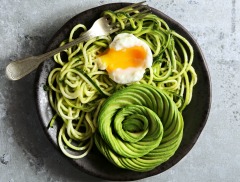Don't just meal plan... meal plan intelligently - with Meal Genius! Sign up for our free newsletter to get delicious recipes, sample meal plans and a whole lot more!
Sauerkraut
Sauerkraut, which translates to “sour cabbage” in German, originated in China over 2,000 years ago where it is known as "kimchi".
While the traditional Chinese fermentation called for rice wine, the dish we know today is made with shredded cabbage, salt and sometimes spices.
Sauerkraut is made by a process of pickling called lacto-fermentation. Lactic acid bacteria - probiotics including Lactobacillus - form lactic acid when these good bacteria ferment sugars in the fresh cabbage.
Sauerkraut is a low glycemic index food that helps to balance blood sugar, is high in vitamin C and contains powerful cancer-fighting compounds including glucosinolates.
The Benefits
- Special diets: Autoimmune Paleo Diet, Candida Diet, Diabetic, Elimination Diet, Gluten-Free Diet, Gluten-Free/Dairy-Free Diet, Grain-Free Diet, Low Carb Diet, Low FODMAP Diet, Low Histamine Diet, Low Oxalate Diet, Low Starch Diet, Paleo Diet (Light), Paleo Diet (Strict), PCOS Diet, Pescetarian Diet, Primal Diet, Thyroid Diet, Vegetarian Diet, Whole Food
- Excellent Source of: VitaminC, VitaminK
- Good Source of: Fiber, Iron, Manganese
- Preferences: No Fish, No Red Meat, No Pork, No Eggs, No Shellfish, No Gluten, No Nuts, No Seeds, No Soy, No Dairy, No Poultry, No Coconut, No Pseudograins, No Corn, No Yeast, No Peanuts, No Citrus, No Nightshade, No Legumes, No Grains, Low Carbohydrate, Low Cholesterol, Low Fat, Low Sugars, Low Saturated Fat
Related Foods
Related Recipes
Related Nutrients
Selecting and Storing
Look for sauerkraut in the cold case or canned foods aisle. Avoid sauerkraut containing preservatives like potassium sorbate.









